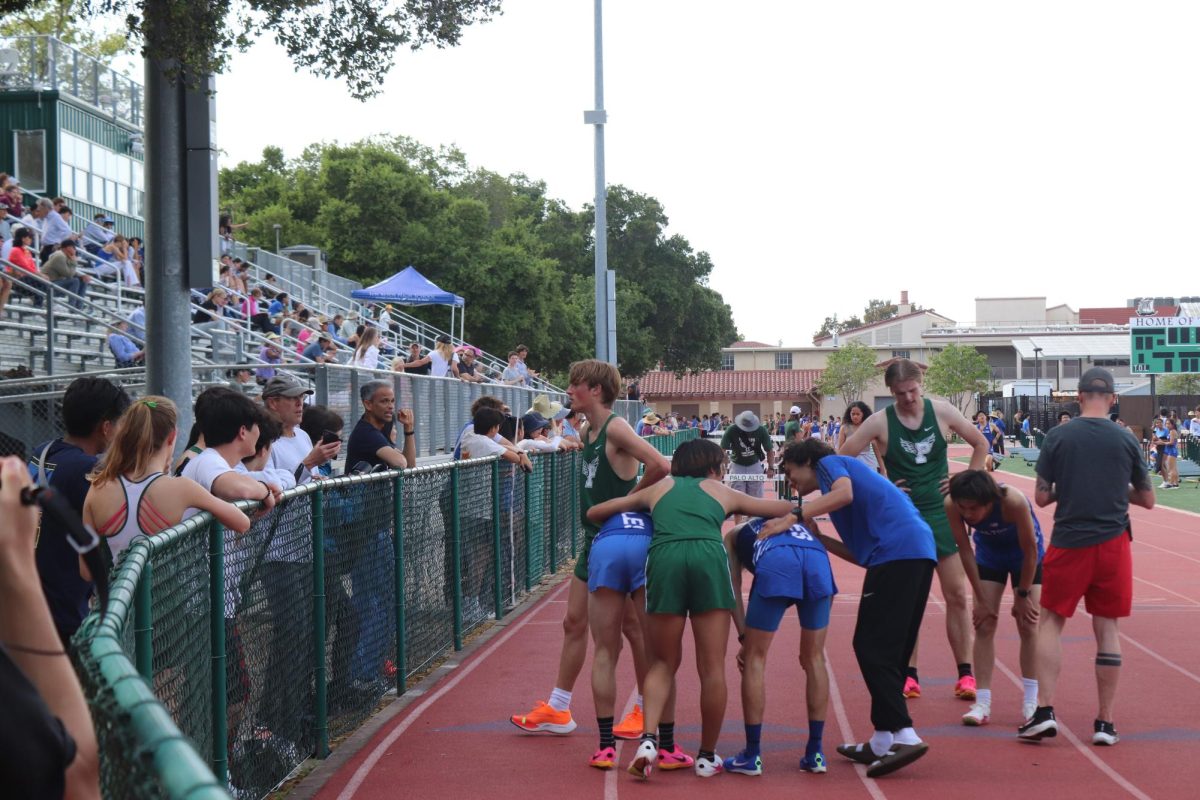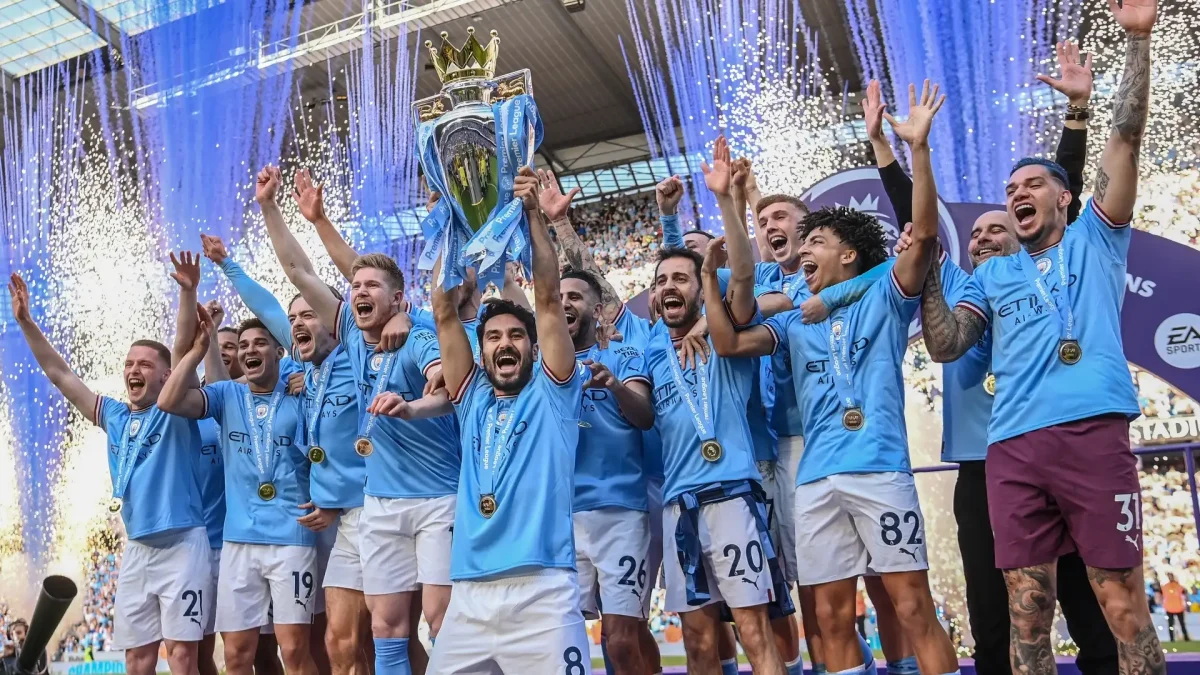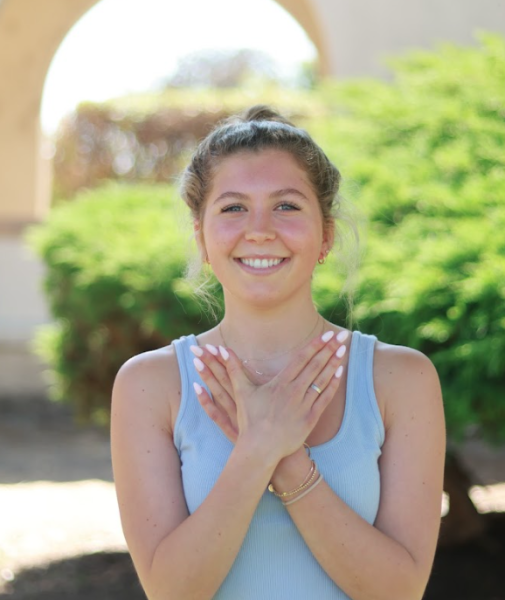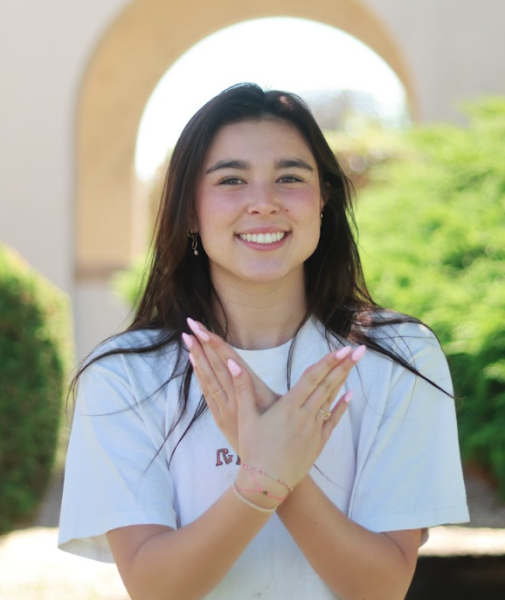Beyond every hurdle, tackle, throw, kick, stunt or plié is an athlete looking in the mirror at a person who feels they should have a certain physical look. Our Paly athletes have the mental endurance to show up for their sport every day, and more importantly, show up for themselves. The power of resilience and growth may be either diminished or improved by the way athletes feel in their skin.
Body image is defined as the multidimensional and dynamic concept that encompasses a person’s perception, thoughts, and feelings about their body.
Athletes across the world can be mentally and physically pushed to reach a specific physical build connected to the sport they play. In many cases, muscular female athletes can be seen as “not feminine enough,” and lean male athletes might be “too small.” Regardless of these examples, there are countless other standards placed on all athletes that can not only impact their ability to perform but also their mental capabilities.
It is essential to know the difference between working hard to be strong and agile and working to achieve a certain look. Body image issues are commonly overlooked, but even more so is the hyperfixation athletes have around nutrition to maintain a certain image.
Paly athletes were asked about their experience with the topic of body image within the community of sport(s) they play. Olivia*, a senior who participates in dance understands that there are certain expectations for dancers to look a certain way.
“I think it’s desirable to be skinny and tall to create long lines since dance is such a visual sport,” Olivia* said. “ Sometimes I feel discouraged and insecure, which causes me to lose confidence in the sport — Olivia*
This lack of confidence can also be associated with an increase in mental illnesses for some athletes. Emma*, another Paly student who participates in dance has more elaborate on this topic.
“Many ballet dancers who have been a healthy weight have been told that they are too heavy,” Emma* said. “Much of the commentary can lead to mental health problems, such as anxiety, depression, imposter syndrome and eating disorders”
When an audience sees a beautiful dancer on stage, with strong, lean muscles and perfect balance, they might not take into consideration the amount of mental pressure put on these athletes. It is essential to understand that with any sport there is a possibility to develop different forms of stress, but dance is one of the most common sports to lead to eating disorders.
The top priority in sports like dance is to celebrate lean athletes who have the stereotypical build of a dancer, which can create an environment where there is little to no body positivity expressed. Body image dissatisfaction can be directly related to unhealthy behaviors like frequent dieting, bulimia, extreme restrictive eating, and a lack of confidence in their performance.
One professional ballerina, Kathryn Morgan, is dedicated to trying to change the unrealistic body standard in dance. A soloist at the Miami City Ballet, she was cut from performing a solo titled “Firebird” because of her size.
“I put the clip of Firebird in there to show the reality of the situation,” Morgan said in an interview with Dance Magazine. “My clothes hanging in my closet are size two and zero and extra small and I am considered a large size. I wanted to show people this is what I look like. This is the reality.”
One of the most common claims used to justify the body standard of ballet and dance in general is that directors have an artistic vision, and that that vision includes smaller women. Morgan, however, feels that these standards are generally unrealistic, and that pursuing them can cause real harm. She mentioned a scenario in which a friend of hers, who was a dancer, was told to try using cocaine to get her weight down.
“When did that become okay?” Morgan said in response to this story. “Yes, obviously you need to be fit and healthy to be a ballet dancer, it is a very physical art form. And yes, the men need to be able to lift you. But I think the problem is that the standard is this sinewy almost prepubescent look. And for many of us that is not doable.”
Morgan recognizes that this is a complex issue, but she seeks to emphasize that excessive preoccupation with one’s body can suck the joy out of a sport.
“I don’t have a perfect answer for how to fix it, but we need to work on it because these poor kids are being damaged,” she said. “ The whole point of being a dancer is to love movement and to love being on stage and we are ruining it.”
Dance is a sport that all too often comes with body image struggles; according to a 2015 study, dancers have a three times higher likelihood of developing an eating disorder compared to the general population. However, individual dancers like Morgan are working hard to dismantle the challenging environment that many dancers have to struggle through.
Furthermore, it is important to acknowledge that there is more to an athlete than just their sport, whether dance or any other sport. Some athletes’ body satisfaction fluctuates as they move between their different social settings. Charlotte* expressed that her body image changed depending on who she surrounded herself with.
“I grew up playing a sport where being taller is an advantage and I am generally pretty tall,” Charlotte* said. “I feel less self-conscious around my teammates who have similar heights than when I am with my 5-feet tall, 100 pound friends.”
This is not an uncommon situation for athletes, especially women, to have a different body image within their sport and when they are in public. In the article, “Global Sport Matters: Body Image Issues,” published in 2019, Dr. Erin Rubenking highlighted “In sports, [an athlete’s body] can be totally normal, and they feel proud of themselves, but then sometimes outside of sports, depending on the athlete, that’s when they begin to feel more self-conscious.”
Part of this may come from the fact that sports focuses more on what the body can do, not how it looks. Sophia*, a Paly swimmer, notices that this impacts her own body image.
“When I’m swimming, I feel good about my body because it’s helping me improve my times and get a good workout,” she said. “But then as soon as I’m at school, the same broad shoulders that I am proud of during swimming become a point of insecurity in a way.”
There are ways to mitigate the risk of developing a negative relationship with one’s body, and instead form a positive environment for athletes of all shapes and sizes. By promoting body diversity, educating professionals and coaches on helping their athletes enhance their well-being, and addressing the body image issues within our community, athletes might accept their bodies and find love for their appearance.
Our modern world is ever-changing, and the stigma around body image is a more widely discussed issue today with soc ial being the primary way to communicate. Many people with online platforms use their accounts to spread information on finding compassion for ourselves as competitive athletes.
ial being the primary way to communicate. Many people with online platforms use their accounts to spread information on finding compassion for ourselves as competitive athletes.
One thing that can help support a good relationship with one’s body is participating in a sport in which many different athletes can find success.
Swimming is a sport that requires physical strength and endurance, but there is no “right” look for these impressive athletes. Sophia*, a swimmer, feels that the sport has a representation of all people.
“Swimmers come in many different sizes and lots of fast people have different body shapes, so it’s not much pressure [to look a certain way],” Sophia* said. “The fastest people on our team don’t look the same, some are super tall or shorter and muscular, but all of them are successful in the water so it doesn’t really matter.”
Our swim team has historically been one of Paly’s strongest athletics programs, not because each person looks the same, but because these athletes have put time, energy, and work into becoming strong athletes. By prioritizing their speed and endurance, the focus on how their body looks is insignificant.
Paly junior Maddie Lee participates in rowing, another example of an extremely physically demanding and time-consuming sport, often assumed to have specific physical criteria.
“Rowing has improved my body image because I look toned and feel healthier, but it also has left me feeling “too muscular” or wanting to be smaller,” Lee said.
Despite some challenges about wanting to fit into a certain body type, Lee recognizes that rowing has given her so many benefits.
“ I remind myself that the sport has taught me lifelong lessons about fitness and exercise, so it’s not much of a worry to feel different — Sophia*
Lee hits on an important point that, though sports can improve body image by actually changing the composition of one’s body, whether gaining muscle or losing weight from working out and training, participating in sports can also improve body image regardless of if your body changes at all.
By building a good relationship with working out, especially if surrounded by other athletes all with different body types, your own body image can improve as your confidence rises and you take advantage of your body’s feel-good hormones during training. Along with that, the mental health benefits that come along with exercise can improve negative emotions surrounding all aspects of one’s life, some of which might include body image issues.
Along with being content with their physical appearance, athletes might find that sports influence them to eat balanced meals and snacks throughout the day as essential benefits to their performance. Athletics can promote healthy nutrition and a balance of all essential foods rather than solely focusing on the way one looks, sports teach athletes to fuel themselves. In addition to his rigorous workouts for his sport, 11th-grade student Liam* understands what he needs to do between his training hours.
“Food is so essential for athletes before and after practice, especially young athletes,” Liam* said. “No matter what, all categories of food should be on the table, meaning fats, proteins, and carbs.”
Those athletes who do prioritize nutrition might also find their body image to be more positive since getting the right nutrients can improve sleep and mood overall.
Paly junior Rohit Sengupta, a mountain biker and tennis player, has effectively improved his mindset through training.
“Mountain biking and tennis both improve cardiovascular health, strength, and endurance, leading to a better physique and a more bulky look,” Sengupta said. “The physical benefits combined with the mental boost from endorphins and skill mastery contribute to a positive body image and self-esteem.”
Sengupta has learned to focus more on physical fitness and improved mood rather than the way he looks. The rush of endorphins, otherwise known as “happy hormones,” released during workouts leads a lot of athletes, including Sengupta, to find body confidence.
Studies have proven that there are mental benefits of exercise on a neurochemical basis. These benefits include an increase in dopamine levels in the brain, which decreases stress and even depression due to the enhancement of those “feel-good” transmitters. Not only are hormones released, but exercise also reduces levels of the body’s stress hormones, such as adrenaline and cortisol.
As stated by the National Institutes of Health, hormonal fluctuations during adolescence alter brain function, heightening self-awareness and sensitivity to one’s surroundings. This heightened awareness, coupled with rapid physical changes and the societal pressure to conform to new standards of appearance renders teenagers particularly susceptible to developing eating disorders and experiencing dissatisfaction with their bodies. The “Spotlight Effect,” or the idea that everyone is focusing on you and your flaws, is particularly common among adolescents and can contribute to a lower self-image.
However, engagement in exercise and sports offers a valuable avenue for managing these hormonal shifts. For Sengupta, as well as countless other students at Play and athletes worldwide, participation in athletics serves as a crucial tool for regulating hormonal balance and fostering a positive body image. Recognizing the powerful impact of sports on body image is essential in supporting the well-being of adolescents navigating this challenging and pivotal stage of development.
Paly sophomore Estelle Dufour, a water polo player and swimmer, has found sports to contribute positively towards body image.
“Sports make you feel and become healthier, which is a huge aspect of self-confidence and body image,” Dufour said. “Personally, feeling healthy and fit improves my body image and how I feel.”
In a study titled “The Impact of Sports Involvement on Body Image Perception and Ideals: A Systematic Review and Meta-Analysis,” it is concluded that participation in sports improves the perception and acceptance of one’s body image, which has been demonstrated and compared to the non-sports population. Through the study, it has been proven that athletes are generally believed to be more satisfied with their bodies. However, based on 15 studies reviewed, there is a greater body image dissatisfaction (BID) in female athletes than in male athletes.
Although this data aligns with the widely accepted notion that men and boys are less susceptible to body image dissatisfaction and the abundance of disorders that accompany poor body image, Paly 9th grader Oliver* provides his two cents on why this might be and his experience with body image.
“There is a dangerous stigma around male body image and this has caused me and probably other boys to shy away from expressing these stereotypically ‘female’ insecurities,” Oliver* said.
Oliver wants to highlight that men and boys can struggle with body image as well. IN the future, perhaps movements online that are typically geared towards women, like body positivity, can be accepting to men who wish to express their insecurities.
According to “The Body Project” published by Bradley University, “Men tend to be quieter about their body negativity, seeking treatment less frequently or holding off on treatment longer than women due to shame (Brennan, Lalonde, & Bain 2010; Burlew & Shurts 2013).”
Oliver* also highlights the difference between his experience with body image and the public perception of male body dissatisfaction.
“I feel like the male body image tends to be misunderstood,” Oliver* said. “I feel like a lot of people presume that we are only concerned with perceived lack of muscle when I feel like it’s much more complex than that.”
In the same way that some women might want to be thinner, but others want to have more muscle, be taller, or even gain weight or curves, men also have complex relationships with their bodies, but these nuances are often glossed over.
These differences and complexities of how each gender relates to negative body image are important when it comes to recognizing the stigma for male athletes. Society must turn attention to male body image just as much as we validate and seek to make it positive for women. Nevertheless, the issue is ongoing and impacts all athletes, regardless of sex.
One way to combat negativity around body image is body neutrality, a rising mentality to help all people feel comfortable in their skin. Paly student 10th grader Ava* understands the idea of body neutrality, which differs from body positivity, and simply describes prioritizing a healthy and functioning body rather than an outside appearance.
“My body does what it’s supposed to, so I try to be thankful for that and put aside the visual aspects of it,” Ava* said.
Due to the Body Positivity movement, an online movement that was created to help serve as an appreciation of all parts of one’s body (founded in reaction to the “Heroin-chic” eras venerating extreme thinness of the 90’s and the 00’s), many people can find confidence and joy in their body, despite insecurities. But, while body positivity may help some, it can be harmful to promote constant unconditional self-love and has even become toxic, at times promoting unhealthy eating by comparing keeping a healthy and balanced diet to dangerous conditions like eating disorders.
It is both unrealistic and ineffective to expect unabating appreciation for every inch of one’s body. Instead of taking energy to always love your body, a much more comfortable and attainable goal promoted by body neutrality is finding peace with it; not being enamored with your appearance all the time, but overcoming insecurities and not dwelling on them.
“It’s unrealistic to always absolutely love what I see in the mirror, but I also realize that it shouldn’t be normalized to dislike what I see,” Ava* said. “I honestly feel pretty opposed to my body.”
Something that might deter athletes from delving into the “body neutrality” mindset is the notorious issues within social media platforms.
Social media has been a major contributor to body image struggles by creating unrealistic beauty standards and encouraging insecurities. It has managed to turn natural components of the human body into new things to be insecure about. While some view sharing your insecurities as helpful, by showing those with the same insecurities that they are not alone, it also can create new insecurities in others. As various trends emerge and fade, people can feel constant dissatisfaction with their bodies.
Pressure to fit these standards is overwhelming, especially with the rise in editing platforms. Filters, photoshop, plastic surgery and other tools contribute to creating idealized versions of beauty. Constant exposure to photos or videos online that are carefully curated and edited sets an unreachable benchmark and fails to accurately portray reality. If creators are not honest about how they portray themselves on social media, it can leave dismayed followers wondering, “Why haven’t I grown up to be perfect like this celebrity has?” Social media facilitates a comparison culture that causes others to develop low self-esteem and feelings of inadequacy when they see others’ seemingly “perfect” bodies. Paly sophomore and water polo player Maeva Herbert-Paz highlights what she notices from her experience on social media.
“There are so many people to compare yourself to online, and a lot of competition online in general,” Herbert-Paz said. “Genetics play a big role in different body types, and people can create unrealistic beauty standards by posting their body on social media, causing other people to compare themselves to a body even when no matter how hard you work you won’t be able to achieve that body type.”
Someone may open a social media platform and see dozens of photos or videos from fashion models, influencers, fitness models, or other athletes and feel pressured to match their physical appearance, causing them to set unsustainable and unhealthy goals as an athlete. Paly junior and gymnast Svina Narang adds to how the media can add pressure to athletes and their performance.
“Unrealistic standards set in the media are harmful for many athletes, and even standards set for gymnasts, in particular, to look ‘strong enough,’ for example, have a really negative effect on gymnasts,” Narang said.
Social media can also spread false information about what is healthy and unhealthy, especially regarding nutrition. It is easy for athletes to take advice without doing further research after hearing information online.
However, it isn’t all bad. Social media has many benefits in promoting positive ideas about body image. Social media creates an outlet for well-known, influential athletes to share their everyday life, causing others to feel more comfortable about themselves and normalize healthy habits. Other encouraging content like fitness advice, community support, and education is also prevalent across media platforms.
“Social media can bring more awareness to disordered eating and what a healthy body can look like as well,” Social media can bring more awareness to disordered eating and what a healthy body can look like as well — Maeva Herbert-Paz
Additionally, when used positively, social media can contribute to a more inclusive and diverse representation of all body types. Influencers can help promote unique features and alternative beauty standards that both celebrates the beauty in differences and combats traditional beauty standards. Through seeing successful athletes or anyone with a familiar body type, athletes might find comfort and reassurance in themselves to help feel more comfortable in their own skin.
There are countless complex correlations between body and mind for athletes, of both positive and negative dimensions. A positive body image can empower athletes to excel in their sport and personal lives, while a negative body image can deter athletes from their athletics. Fostering confidence and embracing the body diversity within sports is essential to making sports more inclusive for all.
It is essential to push back against the superficial factors of sports, and consider each body to have a physical rather than visual purpose. Your body isn’t an ornament, but rather a tool to maintain and utilize.









